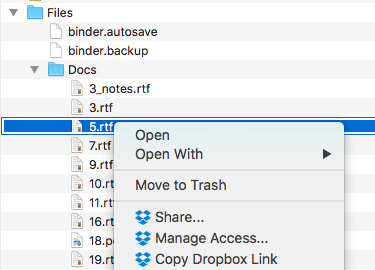
I’ve been tempted to try out Beeminder’s URLminder integration after their most recent blog post, and for added procrastinating fun time, I went out looking to make this work with Scrivener. If you’re not familiar with it, Scrivener (Mac, Windows) is a widely used application for writers, both fiction and non-fiction. I highly recommend it for anything long-form.
Scrivener on OS X (not sure how it works on Windows) creates a single package-style file, which is actually a folder. This kind of “file” shows up as a, well, file on Finder but you can right-click on it and select “Show Package Contents” to view the files.

If you have saved this in your Dropbox folder, any of these files can have a shareable link. In the subfolder “Files/Docs” of the package folder, Scrivener saves a single file in RTF for each part of your document (you can have a document split into different parts/files and have them in a tree structure for easier navigation between chapters/sections).

So, all you have to do is
– Open Scrivener and start a new document
– Make sure it is saved in your Dropbox folder
– Find the files of the Scrivener document in Finder
– Make a note of the shareable link of the file – if you have multiple parts/sections, make a note of each file for each section
– Go to Beeminder and start a new goal with URLminder integration
– In the text box of the Beeminder new goal page, place the link(s) one for each file/section of your document.
Later, if you add more sections, you can add more URL in the URLminder part of your Beeminder goal’s settings.
Alternatively, under a “Preview” subfolder of the Scrivener document’s contents, you can find a “Preview.html” which is an HTML file of your entire document. However, it seems you get a much larger word count if you try to track that.
Both ways are not very accurate (you get larger numbers than the correct ones) but at least you have an (analogous to the real number) metric that is automatically synced with Beeminder. Scrivener saves your document on exit, so there is zero friction in updating Beeminder. All you have to do is write!
For more accuracy, you can also use Scrivener’s “Compile” function to export a text-only version of the document, and then link the exported file to Beeminder/URLminder. But you will need to remember doing this every time you have made some progress.
To get started, head over to Beeminder.
Also published on Medium.
Tags: beeminder, Dropbox, howto, Productivity, quantified self, Scrivener, tips, writing




